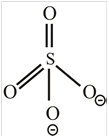
(a)
The shape of the molecule
N 2 O
(a)
Answer to Problem 32E

The molecule
Explanation of Solution
Given Info: Refer to Table 12.6 in the textbook to predict the shape of the molecule.
Explanation:
The shape of the molecule

The central atom has two surrounding regions.
The polarity of a molecule depends on the electronegativity of atoms in that molecule and the shape of the molecule. A molecule which has one polar bond is polar.
A molecule which has all nonpolar bonds is nonpolar.
The symmetric molecule will be nonpolar because the polarity of bonds is canceled out. Thus an asymmetric molecule is polar because the polarity of bonds is not canceled.
Therefore, the asymmetric molecule
Conclusion:
Therefore, the shape of the molecule

The molecule
(b)
The shape of the molecule
SO 4 2 −
(b)
Answer to Problem 32E

The molecule
Explanation of Solution
Given Info: Refer to Table 12.6 in the textbook to predict the shape of the molecule.
Explanation:
The shape of the molecule

The central atom has four surrounding regions.
The polarity of a molecule depends on the electronegativity of atoms in that molecule and the shape of the molecule. A molecule which has one polar bond is polar.
A molecule which has all nonpolar bonds is nonpolar.
The symmetric molecule will be nonpolar because the polarity of bonds is canceled out. Thus an asymmetric molecule is polar because the polarity of bonds is not canceled.
Therefore, the symmetric molecule
Conclusion:
Therefore, the shape of the molecule

The molecule
(c)
The shape of the molecule
GaH 3
(c)
Answer to Problem 32E

The molecule
Explanation of Solution
Given Info: Refer to Table 12.6 in the textbook to predict the shape of the molecule.
Explanation:
The shape of the molecule

The central atom has three surrounding regions.
The polarity of a molecule depends on the electronegativity of atoms in that molecule and the shape of the molecule. A molecule which has one polar bond is polar.
A molecule which has all nonpolar bonds is nonpolar.
The symmetric molecule will be nonpolar because the polarity of bonds is canceled out. Thus an asymmetric molecule is polar because the polarity of bonds is not canceled.
Therefore, the symmetric molecule
Conclusion:
The shape of the molecule

The molecule
(d)
The shape of the molecule
NH 2 Cl
(d)
Answer to Problem 32E

The molecule
Explanation of Solution
Given Info: Refer to Table 12.6 in the textbook to predict the shape of the molecule.
Explanation:
The shape of the molecule

The central atom has four surrounding regions.
The polarity of a molecule depends on the electronegativity of atoms in that molecule and the shape of the molecule. A molecule which has one polar bond is polar.
A molecule which has all nonpolar bonds is nonpolar.
The symmetric molecule will be nonpolar because the polarity of bonds is canceled out. Thus an asymmetric molecule is polar because the polarity of bonds is not canceled.
Therefore, the asymmetric molecule
Conclusion:
Therefore, the shape of the molecule

The molecule
Want to see more full solutions like this?
Chapter 12 Solutions
Bundle: An Introduction To Physical Science, Loose-leaf Version, 14th + Enhanced Webassign Printed Access Card For Physics, Multi-term Courses
 An Introduction to Physical SciencePhysicsISBN:9781305079137Author:James Shipman, Jerry D. Wilson, Charles A. Higgins, Omar TorresPublisher:Cengage Learning
An Introduction to Physical SciencePhysicsISBN:9781305079137Author:James Shipman, Jerry D. Wilson, Charles A. Higgins, Omar TorresPublisher:Cengage Learning Modern PhysicsPhysicsISBN:9781111794378Author:Raymond A. Serway, Clement J. Moses, Curt A. MoyerPublisher:Cengage Learning
Modern PhysicsPhysicsISBN:9781111794378Author:Raymond A. Serway, Clement J. Moses, Curt A. MoyerPublisher:Cengage Learning


